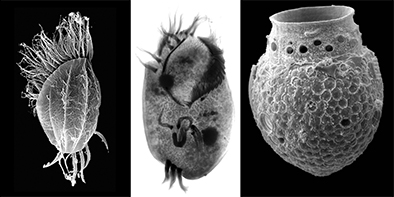
Ciliates (Phylum Ciliophora) are a well-defined, monophyletic group of unicellular protists. With the exception of the ‘primitive’ karyorelictids, they are characterised by having two types of nuclei, i.e. at least one macronucleus and one micronucleus. Another distinctive feature is conjugation, a sexual phenomenon during which gamonts partially and temporarily fuse (gamontogamy). On the outside, the ciliate cell is covered by few to many cilia or compound ciliary organelles (cirri) anchored in the cortex (outer cell layer) by a complex infraciliature (kinetosomes and closely associated microtubules and microfibrils). Somatic and oral cilia and cirri, which are mainly used in locomotion and food gathering, are often arranged in rows (kineties), but these can be considerably reduced or even lacking in some groups or in some stages of the life cycle. Many ciliates are mobile throughout their entire life cycle, but some (e.g. folliculinids, suctorians and most peritrichs) are sessile in their adult stage. Most species belong to the microplankton size fraction (20–200 µm).
Ciliates consume a wide range of food, e.g. bacteria, cyanobacteria, microfungi, microalgae (often diatoms) and other protists (including ciliates), small metazoans, organic particles and dissolved organic matter. Several taxa (usually oligotrichs) are mixotrophic, and at least one species (Myrionecta rubra) is apparently exclusively autotrophic due to a cryptophycean endosymbiont (Lindholm, 1985).
Loricate (mainly tintinnids) and aloricate ciliates are an important component of marine planktonic and benthic food webs. Within the heterotrophs, they are among the numerically dominant groups (Sorokin, 1999). In the plankton of the Southern Ocean, ciliates can reach abundances of up to 29,000 individuals per litre (Sorokin, 1999) and account for 54–64% of the total zooplankton production (Sushin et al., 1986). Associated with a Phaeocystis bloom, densities may be as high as 150,000 individuals per litre (Davidson & Marchant, 1992b). As in other oceans, aloricate species are usually more abundant than tintinnids (Garrison & Gowing, 1993). High numbers of aloricate ciliates occur also in the endopagial (brine-channels) of Antarctic sea-ice (Garrison, 1991b; Petz et al., 1995) where they, along with aplastidic flagellates, form the dominant portion of the heterotrophic biomass (Garrison & Buck, 1991). A recent investigation in the Ross Sea showed, for instance, that the ciliate population can exceed 400,000 individuals per litre of melted ice (biomass 2.8 mg carbon per litre) in older brown ice (Petz, unpublished data).
Ciliates are identified by body shape, size and colour, the shape and arrangement of the somatic and oral ciliature, the shape and number of macro- and micronuclei, the position and number of contractile vacuoles, and other characters in certain groups (e.g. extrusomes, nematodesmata, loricae, body appendages, dorsal silverline system, behaviour). Not all of these features are recognisable in fixed specimens, so that in vivo observations are frequently required for an accurate identification. Tintinnid loricae exhibit considerable infraspecific variability between generations in many (all?) species and are consequently a rather unreliable taxonomic character (e.g. Laval-Peuto, 1981; Van der Spoel, 1986; Petz et al., 1995; Wasik, 1998).
This compilation illustrates the considerable diversity of ciliate species in the Southern Ocean. At least 161 species, 47 tintinnid and 114 aloricate taxa from 85 genera, have been recorded and are described here; several others were only incompletely identified. In addition to the genera treated below, one or more unidentified species of Acineta, Chilodonella, Coleps, Dileptus, Ephelota (epizoic on krill), Epiclintes, Metacystis, Paraurostyla, Parundella, Peritromus, Rhabdoaskenasia, Scyphidia, Trochilia and undetermined, peritrich ciliates (Fig. 14.193) were also found in the Southern Ocean (Thompson, 1972; Thompson & Croom, 1978; Corliss & Snyder, 1986; Heinbokel & Coats, 1986; Rakusa-Suszczewski & Nemoto, 1989; Valbonesi & Luporini, 1990c; Petz et al., 1995; Alder & Thompson, 2000; Song & Wilbert, 2002a; Stankovic et al., 2002; Petz, unpublished data; Petz & Valbonesi, unpublished data; Scott, unpublished data). This suggests that ciliate species diversity is even higher than is currently known.
Related Links
The following references and weblinks may be useful to the user:
Images and classic taxonomic monographs
The Biology and Ecology and Tintinnid Ciliates Models for Marine Plankton. Dolan, J.R., Montagnes, D.J.S., Agatha, S., Coats, W., Stoecker, D.K. eds. 2013. John Wiley & Sons Ltd.